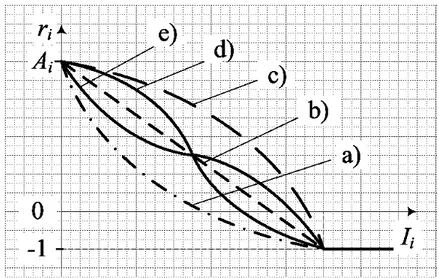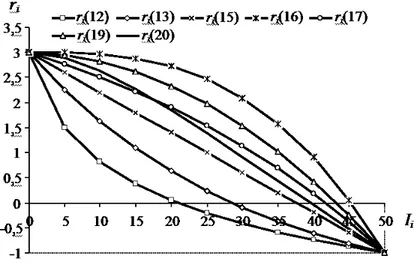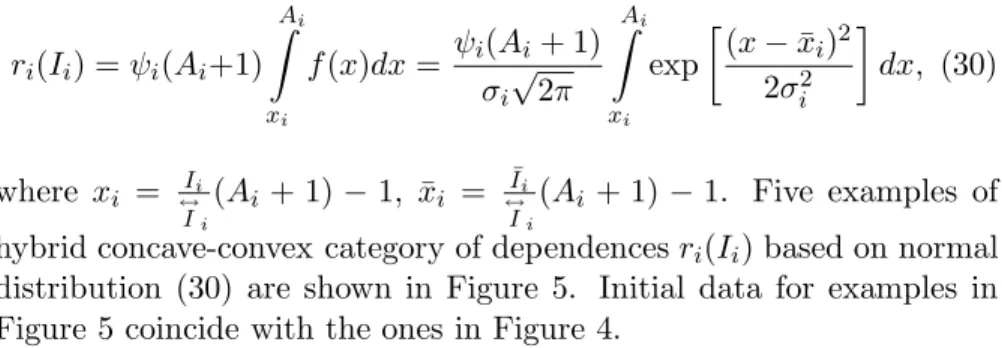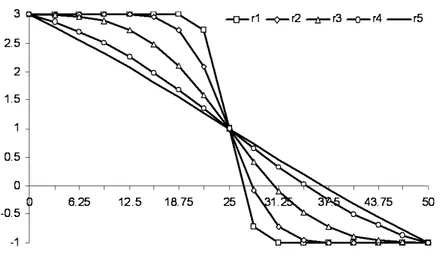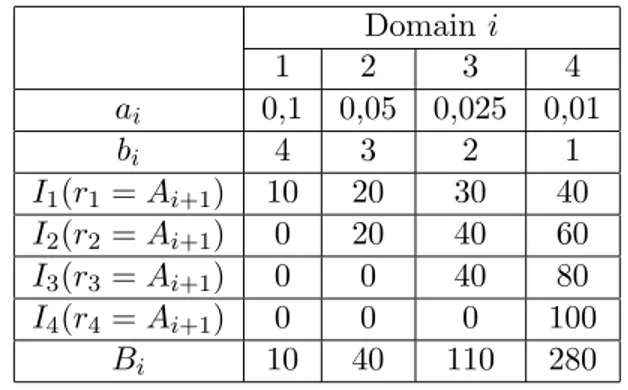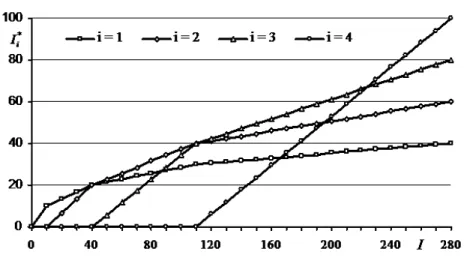Formation of the portfolio of projects for
informatization programs
Ion Bolun
Abstract
Aspects referring to the formation of portfolio of projects for investments in informatization programs are approached: criteria of efficiency, general problem, aggregate problem in continuous form, general problem in discrete form and solving of problems. As criterion of informatization projects’ economic efficiency, the total profit maximization due to investments is used. In pre-liminary calculations, the opportunity of considering continuous dependences of profit on the volume of investments by domain activities is grounded. Eleven classes of such dependences are investigated and analytical solutions and algorithms for solving formulated problems are described.
Keywords: project, informatization program, efficiency cri-teria, investments, optimization.
1
Introduction
Efficient informatization essentially contributes to economic develop-ment and society prosperity. Offered advantages impose the informa-tization of diverse activities at different levels of society: citizens, pro-cesses, workgroups, subdivisions, economic units (enterprises, organi-zations and institutions), economic activities (sectors, branches) and society as a whole. Informatics means are largely used in technical devices, machines and technological processes. For tens of years, in economically developed countries, but not only in such ones, an active government promotion policy in the domain is realized. A more recent
c
example is the realisation of European Union’s programs: eEurope 2002, eEurope 2005 and i2010.
Informatization in a large scale foresees a vast and complex set of scheduled in time works. For a concrete object and period of time, basic works are realized in form of projects, included in an Informati-zation program. InformatiInformati-zation programs can be for a short or mid period of time and strategic programs – for a long period of time. Each project of such a program is oriented to the complete or partial informatization of well-defined functions, aiming to accomplish certain objectives – objectives that will assure provided positive effects. In their turn, informatization effects are different for different projects and the realization of each project needs financial, material and labor resources spending. Therefore, it is important to determine priorities for the efficient use of available resources. Improving the efficiency of expenditures with informatization foresees the formation of portfolio of projects of each program in such a way that it will assure the best ratio between expected effects and the resources spending [1, 3, 4, 11]. The Informatization program can be influenced by such factors as: used efficiency criteria, volume of available resources, accomplished de-gree of informatization, etc. Criteria of economic efficiency, opportune for the estimation of investment projects, were discussed in many pa-pers [1-4], inclusive, more recently for informatization apart, in [11-13]. A general problem for the formation of portfolio of informatization projects, aiming to maximize the total profit P due to investments I in these projects, is formulated in paper [14]. For the aggregate con-tinuous form of this problem, nine dependences of the concon-tinuous rate of returnri by the volume of investments Ii in domain iare proposed
and investigated in paper [15]; these dependences are destined to con-cretize the general problem. Six particular problems in the aggregate continuous form, differing by dependencesri(Ii) only, are investigated
in [16]. For the case of linear dependenceri(Ii), the optimal solution
in analytical form is obtained. An algorithm for numerical solving of problems in aggregate continuous form, for which inverse dependences Ii(ri) is possible to determine in an explicit analytical form, was
numerical solving of the general aggregate problem in continuous form was described in article [17]. In this paper, a summary of results, ob-tained in the domain, is done and the general problem in discrete form is investigated.
2
Preliminary considerations
An informatization object (enterprise, institution, economic activity, society as a hole) can be characterized by activity domains. Domain i foresees the accomplishment of a set of functions. The informatization of a function results with a certain effect. At the same time, for the complete or partial informatization of a function, there are needed cer-tain expenditures of resources, inclusive investments. Investments are done by projects, for each of which, when selecting for the Informati-zation program, indicators of economic efficiency are considered apart. Sometimes, a project can cover, completely or partially, many functions of an activity domain. When complete informatization of all functions referred to domainiis realized, the degree of informatization is –gi = 1.
iinformatization, despite these can depend, sometimes significantly, on the degreeg of the object informatization as a whole.
Letfij,j= 1, Ji be the set of projects, needed for the complete
in-formatization of the domaini, and –Ii – the total volume of investments
needed for the complete informatization (–gi = 1) of this domain. At
a linear dependence of the volume of investments Ii on the degree of
informatization gi of domain i, it takes place the relation
Ii =gi–Ii, i= 1, n. (1)
Let qi be the weight of informatics resources’ capital in domain i
(qi∈[0; 1]), then it takes place the relation
Ii=viqiKi, i= 1, n. (2)
In relation (2), Ki is the total capital referred to domain iand vi
is the capitalization rate of investments Ii.
The used optimization criteria is a primary factor when argument-ing decisions. From the point of view of used criteria, two categories of problems are distinguished: monocriterion and multicriteria ones. Monocriterion problems are investigated in such papers as [1-5, 7, 10, 11]. Indicators proposed in this aim are, usually, composite indica-tors calculated on the base of many primary indicaindica-tors such as: the probability of finishing in time the works on project, the probability of successful implementation of the project, the probability of achieving the outlined objectives, the volume of investment with the project, the outcomes from the project, etc. In the case of informatics projects, a part of these primary indicators became trivial, influencing insignifi-cantly the solution.
be opportune obtaining the solution in two stages: at the first stage, basing on a monocriterion approach, the set of potential projects is reduced, and at the second stage, using the multicriteria approach, the preferable alternative is selected. In the following, the monocriterion approach will be used.
For projects, which are characterized by the equivalence of perfor-mances of functionality and by the ascending dependence of produc-tion expenditures on the volume of investments, in papers [12, 13] it is proved that the maximization of the profit (annual or by the entire pe-riod of the use of informatics products), the maximization of the profit rate, the maximization of the economic effect (annual or by the en-tire period of the use of informatics product), the maximization of the rate of return on investments, the minimization of the time of return on investments, the maximization of the economic efficiency of invest-ments, the minimization of the equivalent costs (annual or total), the maximization of the net present value, the maximization of the inter-nal rate of return and the minimization of the total costs of ownership are reduced to the minimization of the volume of investments. The affirmation is valuable both, for ordinary values and for present values of the respective indicators. Thus, as optimization criteria for such projects, the minimization of the volume of investments can be used, assuring, at the same time, that the optimal solution, obtained con-form this criterion, coincide with the optimal solution obtained using each of the others mentioned above criteria, considerably simplifying the problem.
from problems discussed in papers [12, 13].
From the same considerations of reducing the complexity of the problem, it is opportune to investigate apart the informatization projects with social orientation, and the multitude of available re-sources will be appreciated by the volume of investment I. Thus, it is assumed that there are sufficient labor resources to cover the volume of needed works.
Usually, as optimization criteria for the evaluation of alternatives of goods production or offering the services the maximization of produc-tion volume or profit is used, using such typical producproduc-tion funcproduc-tions as: Cobb-Douglas, with complementary factors (Leontief) or with con-stant elasticity of substitution (CES) [18]. In case of informatization projects, it is more convenient to use, in this aim, the maximization of the profit. This fact is explained by the particularities of investments in informatization. The implementation of some informatization projects results with the reducing of production costs, but not with the increas-ing of production volume. Sure, informatization assures the increase of labor productivity, which permits, in certain conditions, the increase of production volume, too. But both these effects, and many others, are encompassed by indicator ,,profit”. At the same time, just profit constitutes those resources that can be used both, for future develop-ments, inclusive for informatization, and for consumption. Evidently, when needed, the criterion of profit maximization can be, with little adaptations, substituted by the maximization of production volume. Therefore, in this paper, the maximization of profit will be used as optimization criterion.
3
Formulation of the problem
relation R=P/I takes place.
Thus, the problem of Informatization program optimization can be formulated, roughly, as following. Let the volumeI of investments for the partial or total informatization of an object is known. It is required to determine the optimal distribution I∗
ij = α∗ijIij, j = 1, Ji, i = 1, n
of investments I, for the informatization of n activity domains of the object, among projects fij,j= 1, Ji, i= 1, n, aiming to maximize the
total profitP, that is
P =
n
X
i=1
Ji X
j=1
αijPij →max, (3)
n
X
i=1
Ji X
j=1
αijIij ≤I, (4)
where αij is a Boolean variable that takes values 1, if project fij is
included in the Informatization Program, and takes values 0, if it is not included in the program; Pij is the profit due to investments Iij
in project fij. So, the rate of return Rij on investmentsIij in project
fij is determined asRij =Pij/Iij. The profit can be annual or present
(actualized) – the respective concretization will be done, depending on the case.
The multitude of projectsfij,j= 1, Ji,i= 1, n leads to a problem
of large dimension. Taking into consideration the relatively high error tolerance in estimation of projects’ economic characteristics, in prelim-inary calculations it can be opportune to operate only with indicators by domains, without their differentiation by projects. Let Pi be the
profit due to investments Ii in informatization of domaini. Then the
problem (3)-(4) can be formulated, in an aggregate form, as following. It is known the volume I of investments, available for the partial or total informatization ofnactivity domains of the object. It is required to determine the optimal distributionI∗
i,i= 1, nof investmentsI byn
P =
n
X
i=1
Pi→max, (5)
n
X
i=1
Ii≤I. (6)
The profit Pi and investments Ii in informatization of domain i
from relations (5), (6) are determined as:
Pi = Ji X
j=1
αijPij, i= 1, n, (7)
Ii = Ji X
j=1
αijIij, i= 1, n. (8)
Evidently, indicatorsPij andIij (j= 1, Ji,i= 1, n) are the discrete
ones, so dependences Pi(Ii) are the discrete ones, too, in function of
the set of informatization projects. Therefore, both, problem (3)-(4) and the (5)-(6) one, refer to problems of Boolean linear programming. At the same time, the delimitation of the cover area of a project is, frequently, not so strict. It can be reduced or extended, in func-tion of available resources. Also, the estimafunc-tion of resources, needed for the informatization projects, is an approximate one. More over, solving the problem (5)-(6) at discrete dependences Pi(Ii), i = 1, n
is, usually, more complex, comparatively to the case with continuous ones. Therefore, the dependences Pi(Ii), i = 1, n can be considered,
4
Character and definition interval of
func-tions
P
i(I
i),
R
ij(I
i)and
r
i(I
i)The complexity of the aggregate problem (5)-(8) depends on many factors, but most of all it depends on the character of dependences Pi(Ii), i = 1, n. Basing on optimization criterion (5), at restriction
(6) and taking into account relations (7) and (8), one has to give the priority for be included in Informatization Program, to projects with a higher rate of return on investmentsRij. So, all theJiprojects for each
activity domain i have to be arranged in the decreasing order of Rij.
In the following, we will consider, without reducing the universality of investigations, that ordered projects correspond to their numeration j= 1, Ji,i= 1, n; from projects with the same value ofRij, the priority
is given to the project with the lowest Iij.
Let us consider dependences Rij(Ii), i = 1, n, where Rjj is the
rate of return on investments of the project fij for which the relation
j = {k|Ii = k
P
s=1
Iis} takes place. Also, for the continuous form of
the problem (5)-(6), it is useful the introduced in paper [9] notion of continuous rate of return ri on investments Ii in activity domain i,
determined as
ri=ri(Ii) =
∂Pi
∂Ii
, i= 1, n. (9)
Taking into account the defined above rule of including projects in Informatization Program, dependences Rij(Ii) and ri(Ii) are the
non increasing ones, usually even the decreasing ones (considering that there are no two projects with the same rate of return on investments). Evidently, dependences Rij(Ii) and ri(Ii) have both, an inferior
limit and a superior limit values. The respective inferior limit is the value, at which the increase of volume of investmentsIi does not lead
to the increase of revenue Vi. That is the increase of investments in
Rij(Ii), for the respective marginal projectfij and for all the following
projects from theJi ones, the relations ∆Vi =Vij = 0, Pij =−Iij and
Rij = Pij/Iij = −1 take place. Thus, the inferior limit value
⌣ Rij for
Rij is equal to “-1” and to it corresponds the superior limit value
⌢ Ii of
Ii determined as
⌢ Ii =
⌢
ji X
j=1
Iij, i= 1, n, (10)
where⌢ji = min
k=1,Ji
{k|Ri,k−1 >−1}.
Similarly, the condition for the inferior limit value⌣ri of dependence
ri(Ii) is∂Vi/∂Ii= 0, beginning with Ii =
⌢ Ii, and
∂Pi ∂Ii
Ii= ⌢
Ii
=⌣ri=ri(
⌢
Ii) =−1, i= 1, n, (11)
where ⌢
Ii is the superior limit value for Ii that corresponds to the
inferior limit value⌣ri forri.
The inferior limit value of the rate of return on investments equal to ,,-1” is specific, usually, to informatization programs. This leads to the fact that a real informatics system for a relatively complex object doesn’t cover, as usual, all functions of the respective information sys-tem: it is not opportune, from economic point of view, the complete informatization of all objects’ functions. Therefore, the informatization degree of an object doesn’t achieve, as usual, the value 1.
The superior limit of the rate of return on investments ⌢
Rij is
de-termined by the rate of return of the project with the highest rate of return, that is by the rate of return of the project with the highest priority conform to criterion (3). This limit value will be noted as Ai,
taking into account that Ai < ∞. So, the definition interval for the
discrete functionRij(Ii) is
Rij ∈[
⌣ Rij;
⌢ Rij],
⌣
Rij = −1;
⌢
In the same way, the definition interval for the continuous function ri(Ii) is
ri∈[
⌣ ri;
⌢ ri],
⌣ ri =ri(
⌢
Ii) =−1; (13)
⌢ ri=ri(
⌣
Ii) =ri(0) =Ai, i= 1, n,
where ⌢ri is the superior limit for ri. Here
⌣
Ii = 0 is the inferior limit,
corresponding to value⌢ ri, and
⌢
Iiis the superior limit, corresponding to
value⌣ri of investments Ii. So, knowing the definition interval [−1;Ai]
forRij(Ii) andri(Ii), one can determine the definition interval [0;
⌢ Ii] for
Ii. Dependences Rij(Ii) and ri(Ii) are the decreasing ones in interval
[0; ⌢
Ii], that is from
⌢
Rij = Ri1 = ⌢
ri = Ai to
⌣ Rij =
⌣
ri = −1, and
Rij(Ii) =ri(Ii) =−1 for Ii ≥
⌢
Ii,i= 1, n.
Basing on the rule of including in Informatization program the projects with a higher rate of return Rij, from dependences Rij(Ii)
(or ri(Ii) for the continuous case) and Pi(Ii), a primary one is the
Rij(Ii) (or ri(Ii)). Knowing Rij(Ii) (orri(Ii)), one can determine the
dependence Pi(Ii), too. In the case of continuous function ri(Ii), the
dependencePi(Ii) can be determined from the relation (9) that is
Pi =Pi(Ii) =
Z
ri(Ii)dIi, Pi(0) = 0. (14)
In the case of discrete function Rij(Ii), the dependence Pi(Ii) is
determined as
Pi =Pi(Ii) = k
X
j=1
Pij, (15)
Ii= k
X
j=1
Iij. (16)
As mentioned above, knowing the definition interval [−1;Ai] for
Rij(Ii) and ri(Ii), one can determine the definition interval [0;
Ii. In their turn, knowing the definition interval [0;
⌢
Ii], one can
deter-mine the corresponding definition interval [0; ⌢
Pi] forPi(Ii). More over,
because of decreasing character of dependences Rij(Ii) andri(Ii), the
function Pi(Ii) is a concave one in the interval [0;
⌢
Ii]. Therefore, the
function Pi(Ii) is a mono extreme one in the interval [0;
⌢
Ii]. In the
case of continuity of reasonable behavior function ri(Ii) (without
dis-continuities of degree I or II), the maximum of function Pi(Ii), the
maximum profitPmaxi, can be determined from equation
ri(Imaxi) =
∂Pi
∂Ii
I
i=Imaxi
= 0. (17)
In the relation (17),Imaxiis the volume of investmentsIiin
informa-tization of domain i, at which the maximum profit Pmaxi is achieved.
For the aggregate problem (5)-(6) in continuous form the following re-lation takes place:
I∗
i ∈[0;Imaxi], i= 1, n. (18)
Similarly, in the case of discrete functionRij(Ii), maximum of the
functionPi(Ii), the maximum profit Pmaxi, can be determined as
Pmaxi= jmaxi
X
j=1
Pij(Ii), jmaxi ={k|Rik= min j=1,k{
Rij ≥0}. (19)
From practical use, most of the possible alternatives of the de-creasing dependences Ri(Ii) and ri(Ii) are covered by five categories:
Figure 1. Dependences ri(Ii): a) convex; b) linear; c) concave; d)
hybrid1; e) hybrid2.
5
Classes of continuous dependences
r
i(I
i)and
P
i(I
i)Ten typical representations of the five categories of dependencesri(Ii)
from Figure 1 were proposed in papers [15, 17] and investigated in papers [16, 17]. These dependences are (constants ai,bi,ci,si and hi
are nonnegative): 1) convex algebraic
ri =ai(Ii+ci)hi−1−bi, 0< hi <1, bi>1; (20)
2) convex exponential
ri=aie−siIi−bi, bi >1; (21)
3) convex algebraic-exponential
4) linear
ri=−aiIi+bi; (23)
5) concave algebraic
ri=−aiIihi−1+bi, hi>2; (24)
6) concave exponential
ri =−aiesiIi+bi; (25)
7) concave algebraic-exponential
ri =−aiesiIiIihi−1+bi, hi >2; (26)
8) concave parabolic
ri=−aiIi2−biIi+ci; (27)
9) concave-convex algebraic-exponential
ri=aie−sIi(Ii+ci)hi−1−bi, hi >1, (28)
for which nonnegative constants ai, bi, ci, si and hi take such values
that dependence becomes concave on segment Ii ≤ I¨i and convex on
segmentIi ≥I¨i, where ¨Ii corresponds to the inflexion point (atIi= ¨Ii
the equality∂2r
i/∂Ii2= 0 takes place);
10) convex-concave based on normal distribution
Ii(ri) =
↔
Iiψi Ai Z
ri
f(r)dr=
↔
Iiψi
σi√2π Ai Z
ri exp
−(r−r¯i)
2
2σi2
dr, (29)
where f(r) is the probability mass function of the rate of return r on investments in informatization,↔Iiis the total volume of investments for
coefficient, determined as following ψi = 1
,
1−2 −
1 R −∞ f(r)dr ! . In the case of normal distribution, we have f(r) = 1
σ√3π exp
h
−(r−r¯)2
2σ2
i , where ¯r is the arithmetic mean andσ is the standard deviation ofr.
To mention, that in conformity with definition interval (13), for all cases (20)-(29), the relations ri(Ii) = -1 atIi≥
⌢
Ii,i= 1, n take place.
Conditionbi >1 for dependences (20) and (21) is caused by definition
interval (13).
DependencePi(Ii) for (20) corresponds, roughly, to Cobb-Douglas
one factor production function [18]. Exponential dependence, see (21), is frequently used in informatics, including the one for representation of repartition function of laboriousity of the data processing jobs. Depen-dence (22) is a generalization of depenDepen-dences (20) and (21), changing, at si = 0, in dependence (20) and, athi = 1, in dependence (21).
De-pendences (24)-(26) are, practically, dual comparing to the (20)-(22) ones. Dependence (27) is, roughly, a particular case of the (24) one, differing by simplicity. Dependence (28) is determined by the same mathematical expression as in the (22) one, but the definition interval for constant hi differs; this dependence has a more general behavior,
being concave at relatively small volume of investments (Ii ∈ (0; ¨Ii))
and convex at relatively high volume of investments (Ii ∈( ¨Ii;
⌢
Ii]).
De-pendence (29), based on normal distribution, is more flexible than the (28) one.
The dependencesri(Ii) andPi(Ii), defined by expressions (20), (21),
(23)-(25), (27) and (28) and normalized in such a way that for all of them
⌣ Ii = 0;
⌢
Ii = 50 and Ai = 3, are shown in Figures 2, 3 from [15]
by one example for each case.
Five examples of hybrid convex-concave category of dependences ri(Ii) based on normal distribution (29) from [17] are shown in Figure
4. Initial data for these examples are: ⌢ri =Ai = 3,
⌣
ri=−1,
↔
Ii= 50,
¯
ri = 1, i = 1, n; 3σ3 = ( ⌢ ri+
⌣
ri)/2 = 2; σ1 = 0,25σ3; σ2 = 0,5σ3;
σ4 = 2σ3; σ5 = 4σ3. So, the five variants differ only by the value
spec-Figure 2. Examples of dependenceri(Ii).
trum of covered dependences ri(Ii) and, compared to concave-convex
dependence (28), it is considerably more flexible. The high flexibility of normal distribution causes the interest of its use not only for the representation of the convex-concave dependence (29), but for the rep-resentation of a concave-convex one, too. In this aim it is sufficient to invert the use of variables in relation (29), that is
ri(Ii) =ψi(Ai+1) Ai Z
xi
f(x)dx= ψi(Ai+ 1) σi√2π
Ai Z
xi exp
(x−x¯i)2
2σ2i
dx, (30)
where xi = ↔Ii
Ii
(Ai + 1)−1, ¯xi =
¯
Ii
↔
Ii
(Ai + 1)−1. Five examples of
hybrid concave-convex category of dependencesri(Ii) based on normal
distribution (30) are shown in Figure 5. Initial data for examples in Figure 5 coincide with the ones in Figure 4.
Figure 4. Convex-concave dependences ri(Ii) based on normal
Figure 5. Concave-convex dependences ri(Ii) based on normal
distri-bution (30).
From Figures 4, 5, one can see the large spectrum of variants of convex-concave (29) and concave-convex (30) dependencesri(Ii) based
on normal distribution.
From alternatives (20)-(30), one can select the more relevant de-pendence for each concrete informatization domain.
6
Solving the aggregate problem in continuous
form
With dependencesri(Ii),i= 1, nof rational behavior (without
discon-tinuities of degree I or II) atIi∈[0;Imaxi), general aggregate problem
problem (5)-(6) is reduced to solving equation
n
X
i=1
Ii(r)−I = 0. (31)
To obtain the equation (31), it is sufficient to find inverse depen-dences Ii(ri) for the respective classes of dependences ri(Ii). For six
functions ri(Ii), determined by expressions (20), (21), (23)-(25) and
(27), it is easy to obtain inverse dependences Ii(ri) and it is done in
[16]. Moreover, dependence (29) is an inverse one, too. Thus, inverse dependences Ii(ri) are known for seven from eleven functions ri(Ii),
determined by expressions (20)-(30).
By solving equation (31), one can obtain the optimal value r∗ of
rater, and after that determine optimal valuesI∗
i,Pi∗,i= 1, nandP∗,
too. For the case of linear dependences ri(Ii) of form ri =−aiIi+bi
(see (23)), in paper [10] the following optimal solution is obtained
I∗ i = n P k=1 bk
ak −I
ai n P k=1 1 ak + bi
ai
, P∗
i =−
ai
2(I
∗
i)2+biIi∗, i= 1, n. (32)
If equation (31) cannot be solved in an analytical form, then it is relatively easy to solve it by numerical methods, taking into account that Ii(r), i= 1, n are decreasing functions at Ii ∈[0;Imaxi)⊆[0;
⌢ Ii)
and 0 ≤r∗ ≤ max
i=1,n
Ai. An algorithm for solving the problem (5)-(6),
for such cases of dependences, was proposed in paper [16].
A case study, which uses the optimal solution (32), is described in [16]. It is investigated an object with four distinct informatization domains (n = 4), all linear dependences ri(Ii) and constants’ ai, bi,
i= 1,4 values specified in Table 1. Informatization domains are sorted in the decreasing order of constantsbi =Ai,i= 1,4.
In Table 1, values ofBi = i
P
j=1
Ij(Ai+1),i= 1,4, whereIj(Ai+1) are
Table 1. Values ai,bi,Bi and Ij(Ai+1), (i, j) = 1,4.
Domaini
1 2 3 4
ai 0,1 0,05 0,025 0,01
bi 4 3 2 1
I1(r1=Ai+1) 10 20 30 40
I2(r2=Ai+1) 0 20 40 60
I3(r3=Ai+1) 0 0 40 80
I4(r4=Ai+1) 0 0 0 100
Bi 10 40 110 280
Ij(rj =Ai+1) = (bj −Ai+1)/aj, are specified, too. One can see, from
Table 1, that the definition domain for the volume I of investments in informatization is [0; 280] units. Charts of dependencesri(Ii),i= 1,4,
taking into account the definition domain of rateri (6)-(8), are shown
in Figure 6.
Figure 6. Linear dependencesri(Ii),i= 1,4.
The obtained optimal solutions I∗
i(I), i = 1,4, depending on the
dis-Figure 7. DependencesI∗
i(I),i= 1,4.
tributed among the domains 1-3, and at 110< I ≤280 the investments are distributed among the all four informatization domains. The distri-bution of investments among domains, in the frame of each of the four intervals forI (I ≤10, 10< I ≤40, 40< I ≤110 and 110< I ≤280), is of linear dependence by the value of total volume I of investments. Evidently, with each new domain implication in the use of investments, the quota of investments in anterior domains is reduced, although the absolute value of their volume is increased. Also, one can observe that the distribution of investments among informatization domains isn’t a trivial one and depends on many factors.
The obtained results confirm the necessity, at works of large scale, of some special investigations with regard to the distribution of invest-ments for informatization among different activity domains.
The most general form of the aggregate continuous problem (5)-(6) is when inverse dependences Ii(r), i = 1, n cannot be determined in
an explicit analytical form. There are many real cases when we can meet such a situation. Four classes of such dependencesri(Ii) are the
for solving the general aggregate problem (5)-(6) in continuous form is described in [17].
7
Solving the general problem in discrete form
Problem (5)-(8) can be solved using the known algorithms for problems of Boolean linear programming. At the same time, particularities of the problem, permit, in some cases, to simplify the procedure as it is described below.
1o. Initialization.
2o. Sorting them= Pn
i=1
Ji projects in the decreasing order ofRij
val-ues; projects with equal values ofRij are sorted in the decreasing
order of Iij values. The obtained order of projects is s = 1, m
and Rs=Risjs, i= 1, n, j = 1, Ji, whereRs is the rate of return of project fisjs on place sin the overall order of them projects. Also, for simplicity, we note: Cs=Iisjs,Ds=Pisjs,s= 1, m. 3o. Determining the value of k for which the relation Pk
s=1
Cs ≤ I < k+1
P
s=1
Cs takes place. If I = k
P
s=1
Cs or it is reasonably to limit to
investments
k
P
s=1
Cs only, then the solution includes only projects
on places s= 1, kof the overall order, P∗:= Pk
s=1
Ds. Stop.
4o. If they have accepted investments C′
k+1 =I −
k
P
s=1
Cs in project
k+ 1 from the overall order (C′
k+1 < Ck+1), the profit due to
investments C′
k+1 is Dk′+1 and R′k+1 ≥ Rk+2, then the optimal
solution includes only projects on placess= 1, k+ 1 of the overall order,P∗ := Pk
s=1
5o. If Cs = constant, s = 1, m, then the optimal solution includes
only projects on placess= 1, kof the overall order,P∗:= Pk
s=1
Ds.
Investments ∆I =I −
k
P
s=1
Cs are not used. Stop.
6o. Solving the problem by an algorithm of Boolean linear
program-ming (by example, Balash algorithm). Stop.
8
Conclusions
Informatization of diverse activity domains of enterprises, institutions and of the society as a whole has, as a rule, a different impact, that im-poses to establish certain priorities. Some recommendations with refer to the assigning of such priorities, can be elaborated using the proposed and investigated models and procedures. The described eleven classes of dependences of informatization’s economic effects by the volume of investments cover a large spectrum of variants; especially flexible are the dependences based on normal distribution. The obtained results confirm the necessity, at works of large scale, of some special inves-tigations, depending on the case, with regard to the distribution of investments among different activity domains of the informatization object. In some cases, the described approach, with respective im-provements, can be useful for the formation of investment programs in other domains, too.
References
[1] Romˆanu I., Vasilescu I.Economic Efficiency of Investments and of Fixed Capital.– Bucharest: Didactic and Pedagogical Publishing House, 1993.
[3] Vilensky P.L., Liphshitz V.N., Smoleak S.. Estimation of the Ef-ficiency of Investment Projects.– M.: Delo, 2004.
[4] Albu S., Capsˆızu V., Albu I. Efficiency of Investment: Lecture Notes.– Chisinau: CEP USM, 2005.
[5] Mieritz L., Kirwin B.Total Cost of Ownership and the Operations Manager. – Gartner Research, 13 November 2006.
[6] Roy B. Classement en choix en presence de points de vue multi-ples (La methode Electre). Revue francaise d’informatique et de Recherche Operationnelle, 1968, vol.6(8).
[7] Ansoff I. Strategic Management.- Palgrave Macmillan, 1979. [8] Roubens M. Preference relations on action and criteria in
mul-ticriteria decision making. European Journal of Operational Re-search, vol.10, 1982.
[9] Brans I.P., Vincke Ph., Mareschal B. How to select and how to rank projects: The PROMETHEE method. European Journal of Operational Research, 1986, vol.24.
[10] Kyparisisa G.J., Gupta S.K., Ip Ch.-M.Project selection with dis-counted returns and multiple constraints. European Journal of Op-erational Research, vol.94, 1996.
[11] Gaindric C.Luarea deciziilor. - Chi¸sin˘au: S¸tiint¸a, 1998.
[12] Bolun I., Andronatiev V.With Regard to the Criteria of Economic Efficiency of Projects in Informatics. Annals of the University of Economic Studies of Moldova, Vol. 6. – Chisinau: UESM Publish-ing House, 2008.
[14] Bolun I. An Analytical Approach to the Distribution of Invest-ments for the Society Informatization. Economica, nr.1(65)/2009. - Chisinau: UESM.
[15] Bolun I.Character of Dependence of Economic Effects of Informa-tization on the Volume of Investments. Annals of the University of Economic Studies from Moldova, Vol. 6. – Chisinau: UESM, 2009. [16] Bolun I.Distribution of Investments in Informatization Programs / Modernism and Progress in Arts and Sciences. Proceedings of the 33rd Annual Congress of the American Romanian Academy of
Arts and Science, 2009.
[17] Bolun I.Improving the efficiency of investments in informatization / Education, Research & Business Technologies. Proceedings of the ninth International Conference on Informatics in Economy. – Bucharest: ASE Publishing House, 2009.
[18] Gametchi A., Solomon D. Mathematical Modeling of Economic Processes. – Chisinau: Evrica, 1998.
Ion Bolun, Received July 8, 2009
Ion Bolun,
The School of Cybernetics, Statistics, and Economic Informatics, University of Economic Studies of Moldova,
